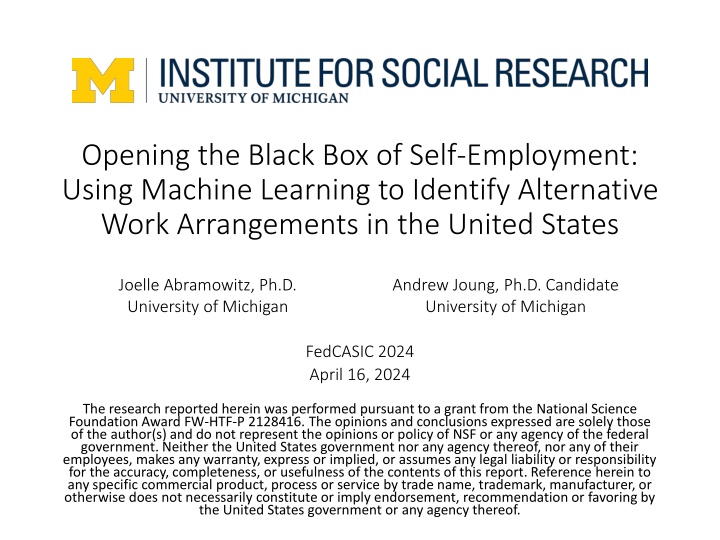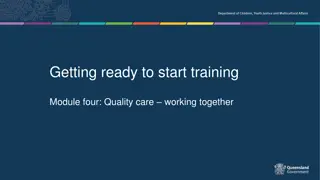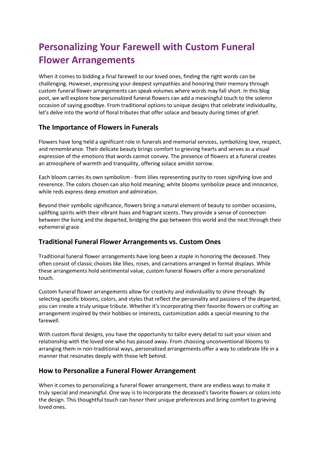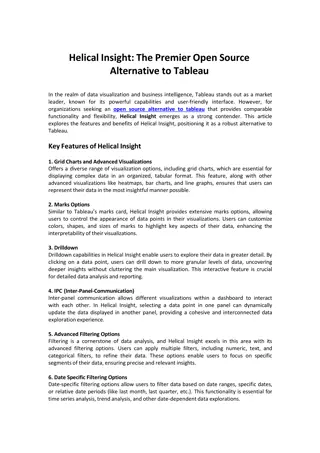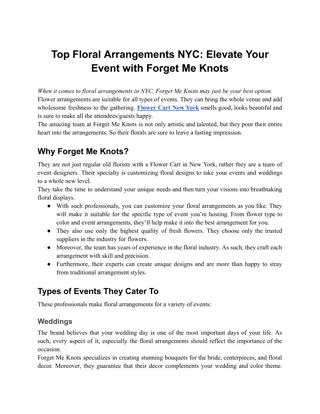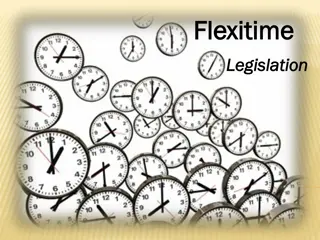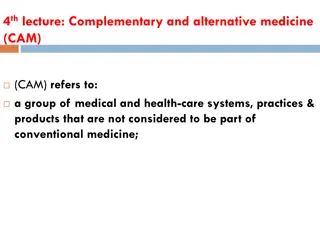Unveiling Alternative Work Arrangements in the US
Self-employment presents challenges in measurement due to diverse work arrangements with varying impacts on well-being. This research utilizes machine learning to classify jobs based on work arrangement type using Panel Study of Income Dynamics data from 2003-2019.
Download Presentation

Please find below an Image/Link to download the presentation.
The content on the website is provided AS IS for your information and personal use only. It may not be sold, licensed, or shared on other websites without obtaining consent from the author.If you encounter any issues during the download, it is possible that the publisher has removed the file from their server.
You are allowed to download the files provided on this website for personal or commercial use, subject to the condition that they are used lawfully. All files are the property of their respective owners.
The content on the website is provided AS IS for your information and personal use only. It may not be sold, licensed, or shared on other websites without obtaining consent from the author.
E N D
Presentation Transcript
Opening the Black Box of Self-Employment: Using Machine Learning to Identify Alternative Work Arrangements in the United States Joelle Abramowitz, Ph.D. University of Michigan Andrew Joung, Ph.D. Candidate University of Michigan FedCASIC 2024 April 16, 2024 The research reported herein was performed pursuant to a grant from the National Science Foundation Award FW-HTF-P 2128416. The opinions and conclusions expressed are solely those of the author(s) and do not represent the opinions or policy of NSF or any agency of the federal government. Neither the United States government nor any agency thereof, nor any of their employees, makes any warranty, express or implied, or assumes any legal liability or responsibility for the accuracy, completeness, or usefulness of the contents of this report. Reference herein to any specific commercial product, process or service by trade name, trademark, manufacturer, or otherwise does not necessarily constitute or imply endorsement, recommendation or favoring by the United States government or any agency thereof.
Motivation Self-employment is difficult to measure and includes a breadth of work arrangements with very different characteristics and effects on wellbeing Ex. Independent contractor for limousine company, owner-operator of taxi cabs, informally driving as a side hustle, and Lyft driver Administrative data and household surveys can suffer from incomplete coverage of the workforce or insufficient detail on work arrangements Administrative records do not capture employment related to income that is not reported to tax authorities and often lack linkages to important demographics and measures of well-being Many household surveys are cross-sectional, do not probe about detailed employment characteristics, and focus on primary jobs only Substantial amounts of work are not captured or are inaccurately captured (Allard and Polivka 2018; BLS 2018; Abraham and Amaya 2019; Bracha and Burke 2021; Abraham et al. 2023) Discrepancies exist across surveys, and between surveys and administrative data in identifying trends in self-employment (Abraham et al. 2013, 2018, 2021; Katz and Krueger 2016, 2019; Abramowitz 2023; Imboden et al. 2023) 2
This project produces novel data to enable understanding trends in the nature and prevalence of different work arrangements We use the 2003-2019 waves of the Panel Study of Income Dynamics (PSID) The PSID is a longitudinal dataset following families over time with over 10,000 families and 24,000 individuals In addition to standard questions about work, the PSID asks respondents open-ended questions about their job industry, occupation, and title along with employer names for *all work* for which they were paid *since the last interview two years prior* We use machine learning of the open-ended questions to classify respondents jobs by type of work arrangement 3
What does the PSID ask about work arrangements? I'd like to know about all of the work for money that you have done since January 1, [P2YEAR]. Please include self-employment and any other kind of work that you have done for pay. Start with any job that you had during this time. What is the name of this employer? What is the official title of your job? (The title that your employer uses.) In your work for [EMPNAME] ([BEGMO/BEGYR] [ENDMO/ENDYR]), what is your occupation? What sort of work do you do? What are your most important activities or duties? What kind of business or industry is that in? 4
Classification approach Uses narratives and employer names along with machine learning to classify work arrangements we start with ~170,000 narratives Two individuals used open coding to review a small subset of narratives to identify common themes and develop a classification schema 30% of the data was hand-coded: two individuals reviewed each record and a third adjudicated discrepancies Then used machine learning to classify the remainder of the data 5
The schema classified work arrangements into seven categories Classification Schema Any mention of platform name (per Harris and Krueger (2015) and Wikipedia list of major gig platform companies), or other indication of platform gig work Platform gig work Self-employed, informal (non-contract) basis Reports being self-employed and working in roles such as a babysitter, caregiver, cleaner, handyman, doing odd/spare jobs, day laborer, maker, performer, seasonal work, multi-level marketing, sales, freelancer Self-employed, formal (independent contractor) basis Reports being self-employed and working in roles such as an independent contractor, subcontractor, consultant, working for an umbrella company (e.g., real estate agent at real estate company, financial planner at advisor company) Business owner or president, or owner of family farm Says they own/run the business OR mentions business assets AND lists business name Reports being self-employed and managing a business, but does not report owning it Self-employed manager Employee or employed manager, not short- term/contingent Does not report any of the above roles and reports working for someone else for pay Short-term/contingent employee Reports working for someone else for pay on a short-term basis or as a temp agency worker 6
Predicting Labels Using Machine Learning Step 1 (Training): Machine learning algorithms (= classifiers) are trained on labeled data in which each narrative is assigned one of the seven schema categories (= labels) Classifiers learn models and get adjusted for better performance Step 2 (Evaluation): Based on the models learned from Step 1, classifiers predict labels for new narratives with labels Step 3 (Implementation): classifiers predict labels for new narratives without labels
We improve on traditional machine learning models by using BERT A classifier is trained on a vector of tokens encoded by a pre-trained language model BERT (Bidirectional Encoder Representations from Transformers) BERT is a language model trained on a huge corpus to predict which word would occur after a sequence of words (masked language modeling) It pre-processes tokens by its own way (WordPiece Tokenizer) and trains itself without labels relying on contextual information of words Narratives are (1) converted into token embeddings, segment embeddings, and position embeddings, (2) fed into BERT to produce representations of tokens, (3) predicted for labels with probability scores by a feed-forward neural network with softmax function
Performance Evaluation Precision (P) & Recall (R) Precision (P) & Recall (R) Trained and tested on hand-labeled data of 48,787 narratives Label A Label B Label C Label D Label E Label F Measure P R P R P R P R P R P R Base Method 0.55 0.37 0.73 0.35 0.71 0.27 0.73 0.36 0.79 0.98 0.00 0.00 BERT 0.00 0.00 0.75 0.81 0.54 0.59 0.68 0.51 0.96 0.97 0.70 0.58 14% of all narratives 69% of all narratives
Automatic Prediction + Post-labeling BERT-based prediction is conducted on the target data of 119,424 narratives BERT-Base (cased) model with hyperparameters of max length = 100, batch size = 16 , epoch = 4, and learning rate = 5e-5 Run on a Linux machine with an NVIDIA GPU (8G RAM) and an Intel Xeon CPU Predicted labels with less than 0.95 probability scores are passed to human coders for manual labeling 11,208 narratives are filtered for manual labeling 9,630 (probability < 0.90) vs 4,627 (probability < 0.85)
One challenge we encountered was implementing the approach in an Internet-free environment The survey narratives are highly classified as they could reveal Personal Identifiable Information about respondents employment We were not permitted to implement the approach in an internet enabled environment We applied the approach on a dumb machine without access to the internet in a secure facility (closet), developing necessary implementation protocols Following implementation, the machined was wiped 11
The result of these efforts is a new variable with the schema categories The machine learning approach allows us to implement these methods at scale in a way that is replicable for classifying future waves of data We can use the variable classifying work arrangements for research and will make it available publicly for use by other researchers It is possible to use this machine learning approach to examine other characteristics of these and other narratives Next, I ll share a few topical findings resulting from the data produced by this approach 12
Examining different types of self-employment shows divergent trends Source: 2003-2019 PSID data including employer names and industry and occupation narratives. Estimates are weighted using cross- sectional weights. Restricted to respondents age 16+ and who report being employed. 13
We see a U-shaped distribution of self- employment over income, but the composition of self-employment varies Source: 2003-2019 PSID data including employer names and industry and occupation narratives. Estimates are weighted using cross-sectional weights. Restricted to respondents age 16+, and who report being employed and non-zero labor income. 14
We also see that employed women are more likely to be informally self-employed while employed men are more likely to be non-informally self- employed Source: 2003-2019 PSID data including employer names and industry and occupation narratives. Estimates are weighted using cross-sectional weights. Restricted to respondents age 16+ and who report being employed. 15
Takeaways and implications for future work Our approach identifies otherwise masked heterogeneity in self- employment work arrangements and permits implement these methods at scale in a way that is replicable for classifying future waves of data The produced data are being made available publicly We also implemented the classification approach on HRS data, revising the HRS classification based on lessons learned from the PSID Future work could use similar approaches to identify other characteristics of interest in these data as well as other types of narrative data in the PSID and other surveys These methods could support changing the way we ask survey questions, for example, asking more guided, open-ended questions This preliminary work is important for identifying the limitations of these approaches 16
Thank You! Joelle Abramowitz jabramow@umich.edu 17
